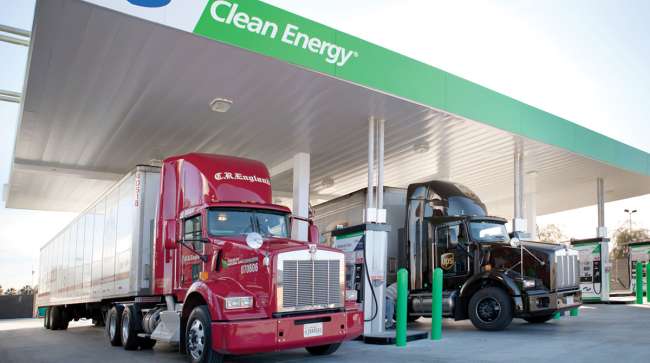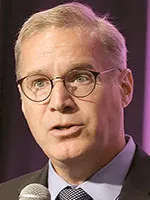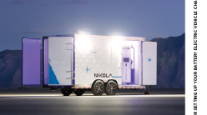Staff Reporter
Electrifying Trucking: $1 Trillion Needed for Infrastructure

[Stay on top of transportation news: Get TTNews in your inbox.]
The trucking industry transitioning to full electrification would require nearly $1 trillion in infrastructure investments, a new study revealed March 19.
The Clean Freight Coalition commissioned the study to gain a better sense of what the switch would cost to inform policymakers and the public. The organization was formed to advocate for lower emissions in trucking, but in an economically effective way. The study concluded that infrastructure upgrades alone would be a nearly $1 trillion expenditure.
“The Clean Freight Coalition is an alliance of transportation stakeholders committed to a clean energy future,” CFC Executive Director Jim Mullen said. “We found that there was a void in information relative to this transition as it relates to the buildup of the nation’s electrical infrastructure, including the generation, transmission and distribution of electricity to electrify all the nation’s medium- and heavy-duty commercial trucks.”
Management consulting firm Roland Berger was commissioned to conduct the study because of its expertise in infrastructure, the automotive sector and commercial trucking. It specifically found $620 billion of investments would be needed for charging infrastructure, with an additional $370 billion to upgrade distribution grid networks.

Mullen
“Our industry has an incredible pedigree and commitment to a clean environment,” American Trucking Associations President Chris Spear said. “What Roland Berger’s study shows us is that this mad dash to zero exposes the supply chain to a $1 trillion unfunded mandate. This is not included in the latest Infrastructure Investment and Jobs Act. This is a $1 trillion unfunded mandate that the supply chain, including our industry, is going to have to invest.”
Spear pointed out that emissions coming out of the tailpipes of trucks have been reduced by 98.5% over the past four decades. That equates to 60 trucks today emitting what one truck emitted in 1988. He stressed that the industry is on board with reducing emissions, but it must be done in a collaborative and common-sense way that isn’t just rushing to one potential solution.

Spear
He noted that means having realistic timelines and targets.
“We looked at the Class 3 to 8 vehicles to understand how they are distributed in the country, what does this mean for the charging situation at the county level, what does it then mean for the investments that have to be taken at the fleet level,” Roland Berger senior partner Wilfried Aulbur said. “Our calculations show that we will have to invest about $620 billion into charging infrastructure, which includes chargers, site infrastructure and utility service costs.”

Aulber
Aulbur believes that the logistics sector as a whole won’t be able to easily absorb the costs considering its 5% return on sales. He warned that without support, the transition could lead to significant freight rate increases to fund it. He also noted that the $620 billion specifically takes into account local and long-distance operations.
“For the local investments in on-site charging infrastructure, we would need close to $500 billion, to be exact $496 billion,” Aulbur said. “Then in addition to the local on-site charging, we need to make sure that there is also on-road charging available for higher-mileage vehicles, which is an additional $69 billion on top. So that’s the way this distributes.”
Aulbur said the development of these highways also is constrained by the pace of transmission grid infrastructure. He noted this process can happen slowly since it requires getting the infrastructure and permits in place.
“Now if we want to look at full electrification of longhaul vehicles, that’s basically the challenge to electrify our highways,” Aulbur said. “That is going to need about $57 billion in additional investment. Again, a significant amount of money that needs to be spent. We’ve said it, infrastructure investment is great, it creates jobs, but we need to find a way to fund it.”
What Is CFC?
The Clean Freight Coalition was founded in March 2023. Its members are:
- American Trucking Associations
- American Truck Dealers, a division of the National Automobile Dealers Association
- Natso
- National Motor Freight Traffic Association
- National Tank Truck Carriers
- Truckload Carriers Association
Aulbur believes the industry needs to look at what is feasible to address these challenges near term, pointing out that this is more so on the infrastructure investment side with power generation and transmission upgrades already being pursued by utility companies.
“We need bridge technologies, we need plug-in hybrids, we need renewable fuels,” Spear said. “We need technology-neutral policies that breed innovation. Going all in on electric, at this pace, it could be catastrophic, not just for our industry, but for the economy and what consumers pay. We’re saying, you can do both. You can get to zero emissions if you do this responsibly.”
Want more news? Listen to today's daily briefing below or go here for more info:




